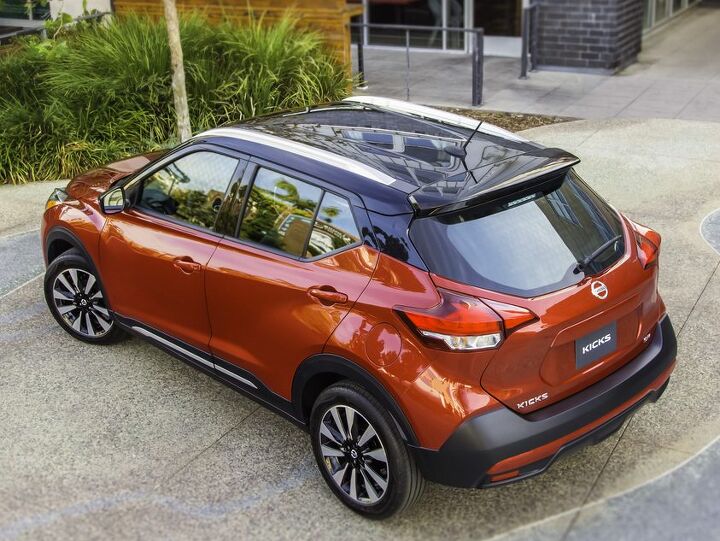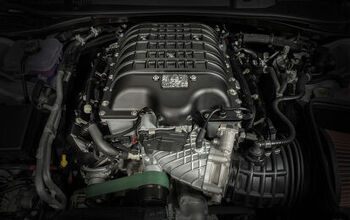The Nissan Kicks Is - Unsurprisingly - Performing Much Better North of the Border

Not concerned with offering all-wheel drive, Nissan’s recently launched Kicks subcompact knows its ground clearance, styling, and low, low entry price is what customers will take notice of, not its perceived off-road prowess. It doesn’t have any (though on dry and flat boulder-free trails, it would probably do fine).
After Nissan unveiled its pricing in the U.S. and Canada, we noticed that the normal north-of-the-border markup was missing in action. As a result, buying a base Kicks S in Canada is just eight bucks pricier than an American purchase ($17,998 vs. $17,990). Both Canada and the U.S. love their big trucks, I said at the time, but this little ute will do better north of the border.
It’s always nice to be proven right.
Having populated dealer lots in sufficient numbers for a couple of months now, it’s clear that, while selling in lower numbers than in the States, the Kicks makes a bigger impact in the Great White North’s Nissan stable.
In August, some 6.1 percent of all Nissan vehicles sold in Canada were Kicks, and in July that figure was 7.6 percent. The U.S. tally shows a much lower demand in relation to the rest of Nissan’s lineup: 3.8 percent of Nissans sold stateside last month were Kicks. July saw a 2.4 percent figure.
With 3,876 sales in the U.S. in August, the Kicks outsold such mini crossover rivals as the Mazda CX-3 (1,481 units) and the Toyota C-HR (3,823 units), but failed to reach the volume enjoyed by the equally new Hyundai Kona (4,772 units) and Ford EcoSport (4,769). Honda’s on another strata of volume with its HR-V, while General Motors keeps data for its strong-selling Chevrolet Trax and Buick Encore (hardly a Kicks competitor) to itself until the end of the quarter rolls around.
In comparison, the Kicks outsold the HR-V in Canada, as well as the C-HR, and likely the EcoSport, too (the model hit a sales high in July that was only 16 units higher than the Kicks’ August tally). Oddly, Mazda sells almost the same number of CX-3s in Canada as it does in the States, so it trounced its front-drive Nissan rival last month.
Inside Nissan’s American lineup, the Kicks outsold — individually — the Versa, Maxima, Leaf, Armada, and both the 370Z and GT-R last month. In Canada, the Kicks outsold all of these vehicles (minus a suddenly popular Leaf), but also the Altima, Pathfinder, Frontier, and Titan. Yes, cross-border differences in vehicle demand are often stark — Wednesday’s look at the buying habits of Jeep customers made that clear.
Regardless of country, Nissan sales rose last month. The brand finished August with a 4.4 percent year-over-year increase in the U.S. and a 1.5 percent increase in Canada, though year-to-date sales favor the north side of the border. Nissan sales over the first eight months of 2018 sank 4.8 percent stateside, but rose 1.9 percent in Canada.
[Image: Nissan]

More by Steph Willems
Latest Car Reviews
Read moreLatest Product Reviews
Read moreRecent Comments
- Jeff Self driving cars are not ready for prime time.
- Lichtronamo Watch as the non-us based automakers shift more production to Mexico in the future.
- 28-Cars-Later " Electrek recently dug around in Tesla’s online parts catalog and found that the windshield costs a whopping $1,900 to replace.To be fair, that’s around what a Mercedes S-Class or Rivian windshield costs, but the Tesla’s glass is unique because of its shape. It’s also worth noting that most insurance plans have glass replacement options that can make the repair a low- or zero-cost issue. "Now I understand why my insurance is so high despite no claims for years and about 7,500 annual miles between three cars.
- AMcA My theory is that that when the Big 3 gave away the store to the UAW in the last contract, there was a side deal in which the UAW promised to go after the non-organized transplant plants. Even the UAW understands that if the wage differential gets too high it's gonna kill the golden goose.
- MKizzy Why else does range matter? Because in the EV advocate's dream scenario of a post-ICE future, the average multi-car household will find itself with more EVs in their garages and driveways than places to plug them in or the capacity to charge then all at once without significant electrical upgrades. Unless each vehicle has enough range to allow for multiple days without plugging in, fighting over charging access in multi-EV households will be right up there with finances for causes of domestic strife.



































Comments
Join the conversation
I haven't seen a Kicks on the road in Edmonton, but tons of Konas. I expect the Kicks will catch up. Despite my hate for these things, Nissan got the look of this right. And, no AWD is no issue. Most of the folks who drive these couldn't tell you if their car was AWD or not. I give Nissan props for revivng the idea of cheap and cheerful.
Isn't it kind of silly to draw conclusions based on, what, one or two months of its being on sale? Let's see what the situation is in six months or a year. p.s. NOT a Nissan fan. Also, many of the biggest jerk drivers on the road drive Nissans, in my observations: tailgating, dangerous lane-changes, etc... (especially Rogues and Sentras).